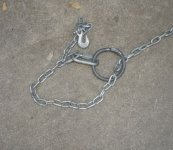I had trouble getting the Simpson company's website to load, until I realized that google was finding the wrong link (started with an http://, but really needed an https:// to work) Finally thought to try the secure web site prefix, and it worked:
Simpson Winch
The Simpson SP/CW winch is powered by a smaller engine (Honda GX35) than the
Portable Winch Company's PCW5000 (Honda GX50), so to get similar pulling power (2000# at 22 FPM for the Simpson vs 2200# for the PCW5000 2200# at 40 FPM), the Simpson unit is geared for lower speeds. (They also make a chainsaw powered winch.)
The Portable Winch company also makes the smaller
PCW3000 winch which is also powered by a Honda GX35 engine. It sells for a similar price as the Simpson unit. The PCW3000 is rated for 1600# @ 33 FPM. The Simpson is rated for more pull, but at a slower speed: 2000# @22 FPM (at 1500#, it will do 25 FPM).
The
Lewis Winch 400 MK2 is powered by your chainsaw. It runs 60-80 FPM (depending on how much cable you have on the drum. Pulling power is dependent on the size of your chainsaw, but it's rated for up to 4000# single line pull. I have heard mixed reviews on these. Some people love them, some can't stand them. Rather than a rope, it winds steel cable onto a drum. It comes with 150' or 3/16" cable. Many people end up cutting the cable shorter, since it can be a pain to get it all back on to the drum.
Which way you go is a matter of personal preference. I think any of them are a better longer-term solution for pulling logs out of the woods than using a 12V electric winch:
- I have seen the PCW5000 in action, and have had a chance to use it a couple of times. I was impressed. If I did not own or could not justify a logging winch on my tractor (or did not have a trctor suitable for mounting a logging winch), I would own one of these.
- I've never seen a Simpson winch or the PCW3000. The light weight would be tempting: 18-20#, but I think I would lean toward the higher pulling power and faster speed of the PCW5000.
- The Lewis Winch sounds tempting with its higher pulling specs. I've only seen one used once. I'm not sure I'd want to mess with the cable on a portable unit. I also would not want to tie up a chainsaw mounting the winch on it. However, some people absolutely love it.


